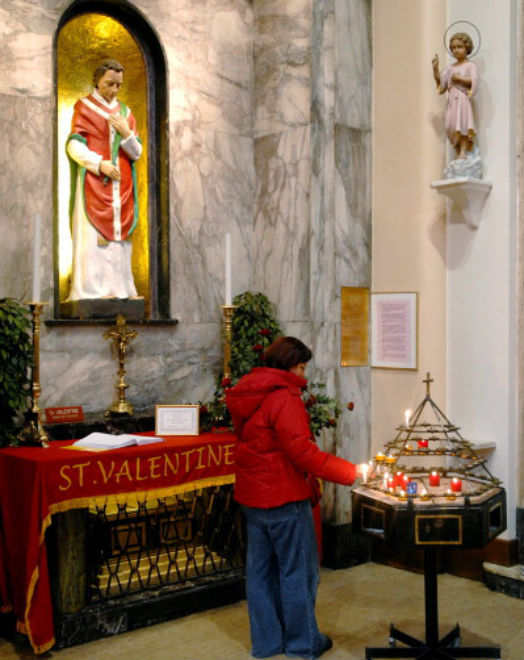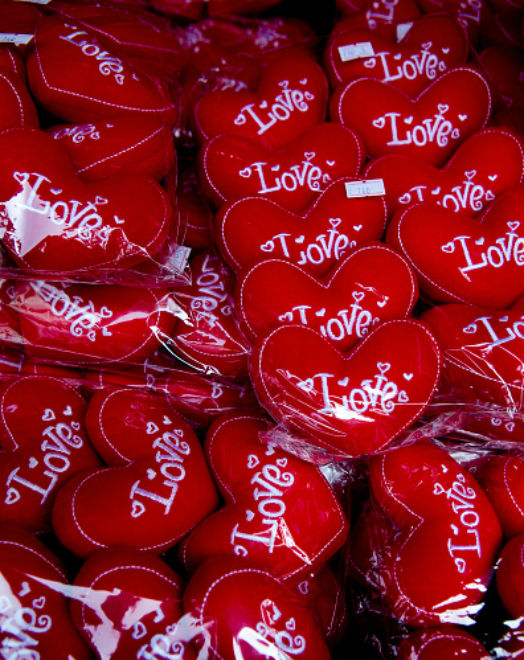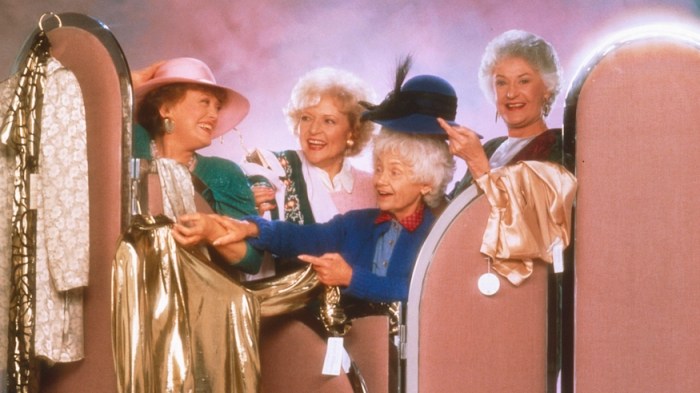Valentine’s Day is almost upon us — and whether you’re a fan or not, there’s no avoiding the candy hearts, Kay Jewelers commercials and pink. Lots of pink. Which begs the question: why is Valentine’s Day celebrated?
You don’t need to put on a sugar-coated smile — no. But have you ever wondered why the world partakes in the ooey-gooeyness of gift giving, candlelit dinners and Hallmark cards? Here’s all you need to know.
Why is Valentine’s Day celebrated?
Why is Valentine’s Day celebrated, anyway? We do it all for Saint Valentine. According to History.com, there are at least three different saints named Valentine, or Valentinus, rooted from Christianity and ancient Roman traditions. They were all martyred (read: killed). Though ranging in narrative, each legend emphasizes his heroism.
Legend #1
One legend says that Valentine was a Roman priest during the third century. Emperor Claudius II (or “Claudius the Cruel”) outlawed marriage for young men because he decreed them to be better soldiers as opposed to husbands with families (because how could one possibly do both?!). Valentine, however, continued to marry young men and women in secret to keep love alive and was sentenced to death when he was found out. This is said to be the most common legend associated with Valentine’s Day.
Legend #2
Another legend states that Valentine attempted to help Christians escape Roman prisons where they were subject to torture. He was found out, then sentenced to death.
Legend #3
It’s also said that Valentine sent the very first “valentine” while imprisoned — this has often been combined with the first legend when recounting the history of Valentine’s Day. The letter was addressed to a young girl he fell in love with (some believe it was his jailor’s daughter). Legend has it, he signed the letter, “From your Valentine,” before his death. What a romantic!
But the history of Valentine’s Day is still, well, confusing
If you’re still asking, why is Valentine’s Day celebrated, we don’t blame you. It’s important to note that Valentine’s Day may have been based on different saints, and so its history is a little muddled. The Catholic Church even removed the day from its calendar in 1969 as part of reforms to “de-emphasize” Roman saints, which also adds to the confusion.
The remains of a St. Valentine have been scattered around the world (at this point, we can’t say it’s the St. Valentine). Some relics reside in Dublin at the Whitefriar Street Carmelite Church (as seen below) where they have been since 1836. John Spratt, an Irish priest, allegedly received these relics from Pope Gregory XVI.

St. Valentine’s skull is claimed to be housed in Rome inside Basilica di Santa Maria. The skull is crowned with flowers, but it’s unclear which Valentine it belongs to. His bones can also be found in Glasgow, Scotland.
Regardless of the relics’ authenticity, people gather at his shrines to pray for good fortune.
Why is Valentine’s Day celebrated in February?
St. Valentine, of course!
It’s believed that we celebrate the day in mid-February to commemorate St. Valentine’s death, which is thought to have occurred around that time in 270 AD (though some sources state that he was killed in 269 AD).
Lupercalia
It’s also believed that the Christian church placed St. Valentine’s Day where it is in order to Christianize an ancient Roman festival called “Lupercalia,” celebrated between Feb. 13 and 15.
13 Feb was the beginning of the Roman festival of Lupercalia http://t.co/p2GZ0ECTDo pic.twitter.com/XqYMT42Mg6
— British Museum (@britishmuseum) February 13, 2015
According to History.com, Lupercalia was a “fertility festival dedicated to Faunus, the Roman god of agriculture, as well as to the Roman founders Romulus and Remus.”
NPR reported that during this festival there was a lot of drinking (cool), and men — fully nude — would undergo sacrificial offerings to the Gods in the form of dogs or goats and proceed to “whip” women with the hides of these animals (not cool).
Apparently, the women would line up for this “whipping” because they believed it would make them fertile (again, not cool).
Also included in the festival was a “matchmaking lottery” in which men drew women’s names from a jar and “coupled up” with them for the remainder of the festivities (yeah…still not cool).
Pope Gelasius I combined St. Valentine’s Day with Lupercalia to “expel the pagan rituals,” stated NPR, and Noel Lenski, a historian at the University of Colorado, told the site that “the Christians put clothes back on [the festival]. That didn’t stop it from being a day of fertility and love.”
Mating season (chirp chirp)
It was commonly believed during the Middle Ages that Feb. 14 was the start of the mating season for birds, which added to the idea that it should be a day of romance, History.com also reported.
Valentine’s Day romanticized
It’s believed that poet Geoffrey Chaucer romanticized the holiday.
The New York Times reported that University of Kansas English professor Jack B. Oruch, who studied Valentine’s Day during his research on Chaucer, argued that romance was not linked to St. Valentine before Chaucer published poems “Parlement of Foules” and “The Complaint of Mars.”
“For this was on seynt Valentynes day,
Whan every foul cometh ther to chese his make”
(For this was on Saint Valentine’s day,
When every bird came there to choose his mate)
–Parlement of Foules (1382)
Chaucer was the first to link St. #Valentine with #love in his poem, “Parlement of Foules” https://t.co/TI7S72vGO7 pic.twitter.com/hNESVpYQfq
— JSTOR Daily (@JSTOR_Daily) February 14, 2016
The oldest known valentine, according to History.com, was a poem entitled “Farewell to Love” by Charles, Duke of Orleans, to his wife, Bonne of Armagnac. It was written while he was imprisoned in the Tower of London after being captured at the Battle of Agincourt during the Hundred Years’ War between England and France.
Modern Valentine’s Day
But why is Valentine’s Day celebrated with all this consumerism? Our beloved Hallmark offered valentines as far back as 1913, which is a long time, but certainly far after the legends of St. Valentine.
In 2017, consumers were expected to spend a total of $18.2 billion on Valentine’s Day, according to a survey from the National Retail Federation (NRF). The previous year, consumers were expected to spend a record $19.7 billion.
This year, NRF predicts we’ll spend almost as much: $19.6 billion. Each U.S. consumer is expected to drop an average of $143.56 on Valentine’s Day, and 55 percent of the U.S. population is estimated to partake in celebrations.
“With the holidays behind them and the winter months dragging along, consumers are looking for something to celebrate this time of year,” NRF President and CEO Matthew Shay explained.

Helen Fisher, a Rutgers University physical anthropologist who studies the evolution of human sexuality, told The New York Times that wanting love is “a basic brain system that evolved millions of years ago.”
“This is a day when one reflects on what you’ve got and what you don’t have,” she said. So why is Valentine’s Day celebrated? We just love being in love!
But some argue that Valentine’s Day can ruin relationships. As Jonathan Fader, Ph.D. wrote for Psychology Today back in 2015, the celebration can result in problems because it comes with expectations (gifts, lavish dinners, etc.), comparisons — especially when everyone is posting their V Day experiences on social media — and, because of this pressure, “magnification” of existing issues.
There’s so much hype around the holiday, and “instead of celebrating relationships only on February 14, we should ideally pay attention to and celebrate our relationships and partners throughout the year,” Fader writes.
By all means, whether you want to spend a night out on the town or cuddle up with your loved ones and some decadent hot chocolate pancakes, go on your merry way and partake in Valentine’s Day. After all, it can be a fun time. But, as Fader concludes, “Gratitude, affection and hard work every day of the week makes a relationship last — not a box of chocolates once a year.”


















